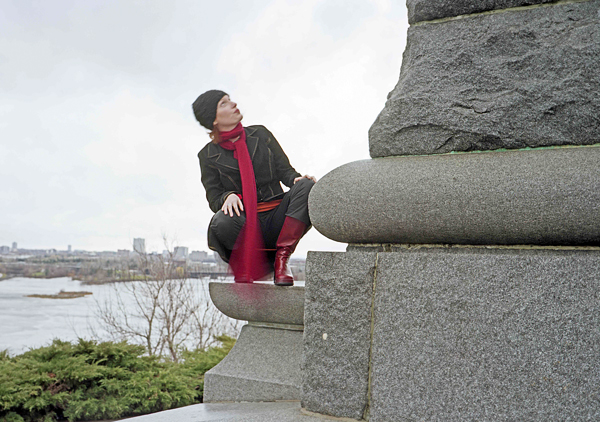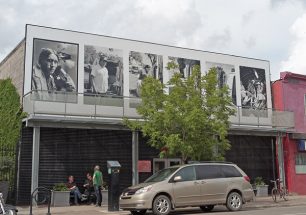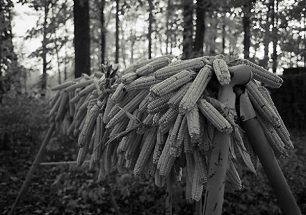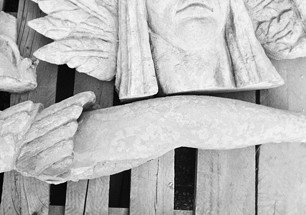CHAMPLAIN SERIES: Caroline Alexander-Stevens
What does it mean to be the subject of someone else’s art?
What does it mean to be the subject of someone else’s history?
What does it mean to be asked to perform for a camera?
In part, it depends on who you are.
I was honored when, in the autumn of 2001, artist Jeff Thomas asked to photograph me as part of his on going project with the Champlain Monument. I had known of his work for close to a decade, and had had the pleasure of his acquaintance periodically over the last year since I began teaching in the School for Studies in Art and Culture at Carleton University. Thomas’ project, as I understood it, was to fill the space left vacant by the recent removal, at the request of the Assembly of First Nations, of the “Indian Scout” who had knelt on a platform at the base of the Monument. Thomas conceptualized this project not a series of formally posed portraits, but rather as collaborations where the subject of each photograph would be provide the opportunity to interact with the Monument as they choose.My initial enthusiasm quickly turned to trepidation. Although I was an experienced performer in a variety of contexts – from the classroom – to participation in large theatrical productions and an emerging practice as a performance artist, the situation that Thomas was creating alarmed me. How was one to act? The history was incredibly conspicuous, the context provocative, and (my perception of ?) the scrutiny of both the photographer and the photograph extreme. Intensifying the situation was an internal dilemma I was experiencing, and had experienced for years as a graduate student; what position could a non-Aboriginal academic occupy in Aboriginal history, activism and politics that would not reinvest implicitly and explicitly in colonial narratives? Having been schooled in the “culture wars” environment of the late 1980’s early 1990’s, I was/am incredibly sensitive to postcolonial issues and perpetually cognizant of how ones own actions – and/or sub conscious beliefs can play into dominant societal narratives of racism. My appointment at Carleton was as an Aboriginal Art Historian, and although this was/is indeed a significant part of my research portfolio and I was/am committed to teaching all art history courses within postcolonial and feminist frameworks, I felt uncomfortable with the authority the position accorded me. I had become the white academic teaching about Aboriginal cultures – a vast, rich and incredibly complicated field for which I felt ill equipped – and in doing so, I feared, replicating colonial patterns of knowledge and power. It was this malady that I wanted to perform for the portrait.
The day that we had agree to meet for the portrait turned out to be one of those miserable cold, grey, damp, depressing days of November – where you cannot escape the fact that winter is imminent. I had not the foresight or reason to have switched to a winter wardrobe so I was cold, but beyond this discomfort I was afraid; afraid of not being performative enough, afraid of not meeting Thomas’ expectations, afraid moreover, of not being able to make visually apparent my unease. I did not wish occupy the platform. Instead, I wanted to stand away from the entire Monument at an awkward angle that might be able to imply a critical distancing. I tried to form my face and body into expressions of dismay and dissatisfaction. Arms crossed – or I think at times shoved deep into the front pockets of my coat, I frowned at the camera trying to articulate “I am aware and critical, not complicit nor part, of this colonial history.” And yet is this possible? Perhaps this is the provocation of Thomas’ project. The removal of the “Indian Scout,” an action that Thomas contested, could be seen as an all too easy way to deal with a shameful history. The erasure potentially eclipsed the need to address the legacies of colonialism. He was compelling responsibility.
As Jeff took the photographs I was unsatisfied with the process. I could not see myself in relation the Monument. The perspective I wanted to achieve seemed difficult – either for me to communicate, or the camera to capture. I wanted to see what the camera saw, to control the gaze, and yet I was not the photographer, nor the authority. I was the performer, the subject being looked upon and evaluated – even if the harshest evaluation was from myself. When I first saw the portrait I was disappointed. I was too small, the monument was too small, there was too much space surrounding us. The camera angle seemed strange and not communicative of what I had intended. Moreover, I read my stiffness as nervousness of the camera and the photographer, not as a thoughtful pose and intentional critique. I blamed myself for these insufficiencies. However, when I saw the photograph recently, four years later, it was different, or I was kinder. The image is moody, intense if distant, certainly uncomfortable. There is a definite defiance, and a strong perhaps overly performative sense to my figure.
These thoughts are just the beginning, there is far more to be said. The project, the process of collaboration, and each of the resultant photographs are rich with layered meaning.
Caroline Alexander-Stevens
Performing Postcoloniality
Art History Department,
McGill University




